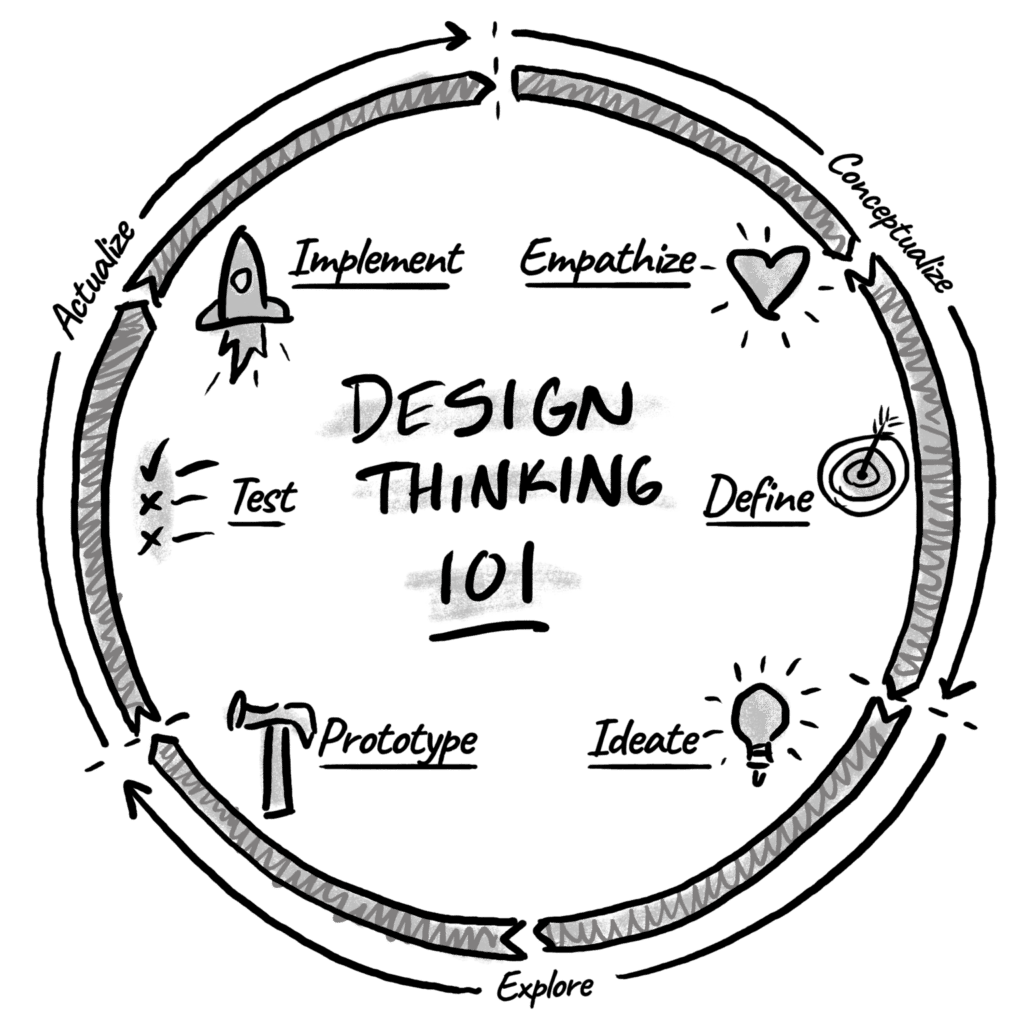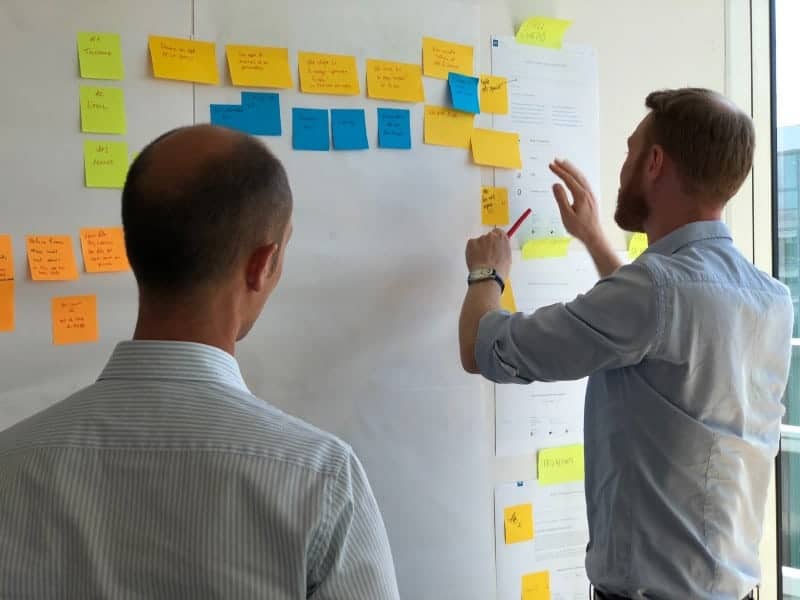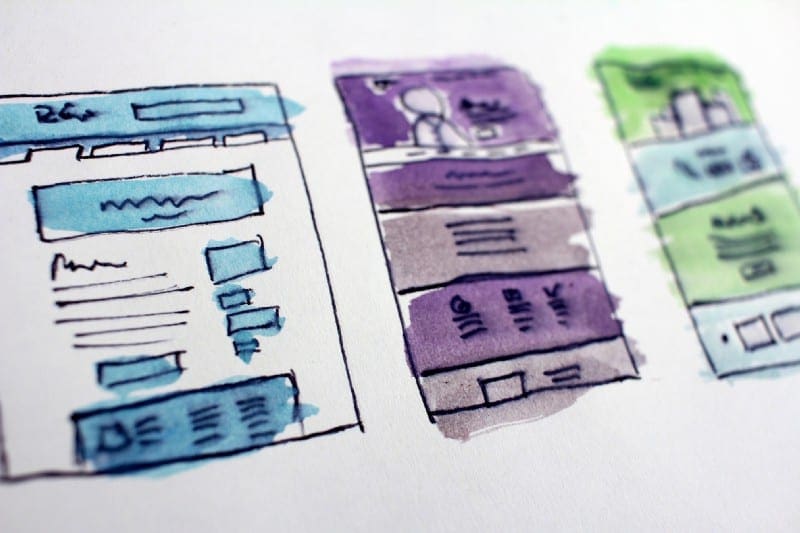The five steps that make up the design thinking process: Empathize, Define, Ideate, Prototype, and Test.
By now, you’ve probably heard about the design thinking methodology. More industries than ever are taking a human-centric approach to evolve their existing products and generating new ideas to serve their customers better by getting curious about actual user needs, ideating potential solutions, and testing them with real users. Let’s take a closer look at what design thinking and user-centered design is and how to apply it to your organization.
According to statistics, 79% of companies agree that design thinking improves the ideation process, and 71% have enjoyed a significant shift in their work culture after adopting design thinking. While it does contain the word design, design thinking and it’s iterative approach to creative ideas is not only for design teams, in fact, any team can benefit from this human-centered design process. We’ve seen product development teams, multidisciplianry teams exploring new business models, customer success teams designing new customer experiences, and countless other examples.

What is the Design Thinking Process?
Design thinking is a process for creative problem-solving that helps teams move past the first “good ideas” and discover creative solutions. Rather than a one-shoe-fits-all mindset, the design thinking approach encourages a holistic view where uncertainty and ambiguity are welcomed and embraced to consider all sides of a problem. A design mindset can be applied to any life situation, and it aids in developing innovative ideas by considering the bigger picture and allowing that to shape our decisions as we move forward.
The method is steeped in a deep belief that the end-user should be at the heart of all decision-making. The benefit of design thinking is that, through empathy for your customer, consumer, or client, you are able to create products and experiences that truly help people and even change lives.
In this article, we’ll explore the five-step process that enables teams to come up with impactful solutions to real problems that are vetted by the people they intend to serve before they’ve even been built. These key steps will launch you into an innovative and experimental design approach.
Pro-tip: use our Liberating Structures templates to get the most out of the design-thinking process with your team. At Voltage Control we also love to use the Workshop Design Canvas.
The 5-Step Design Thinking Process
1. Empathize
The first stage of the design process is to develop a deep understanding of the target audience/customer/consumer and their unique perspective to identify and address the problem at hand. To do this, design thinkers are encouraged to cast aside all assumptions (because assumptions can stifle innovation!) about the problem, the consumers, and the world at large. This allows them to objectively consider any and all possibilities about the customers and their needs.
Typical activities:
- Observations: You’ll go where your users go and see what they care about.
- Qualitative Interviews: You’ll hold one-on-one interviews with a handful of your users to understand their attitudes on the topic you are exploring. Asking someone to tell a story about the last time they experienced the problem you’re investigating provides a rich description that highlights details you might not have otherwise considered. Check out our Interview Observation template to interview someone that is close to the problem you are having and observe the behavior, success, and pain points.
Immersions: Step into your user’s shoes so you can feel and experience their day-to-day.
Tools like empathy maps can be a great way to consolidate all of the valuable information gleaned from interviews. Empathy maps capture what people do, say, think, and feel in the context of the problem. They help colleagues understand the context of the problem and how people experience it, too.

2. Define
Putting together all of the information gathered from emphasizing in the previous step. The next step is to define the problem statement clearly. The ideal problem statement should be captured from the perspective of human-centered needs rather than focused on business goals. For example, instead of setting a goal to increase signups by 5%, a human-centered target would be to help busy moms provide healthy food for their families.
Based on the frustrations you observed or heard about, come up with questions for how you might solve them.
Typical Activities
- Clustering and Themes: There are a lot of different ways to go about the Define phase, but it’s safe to say you’ll need a wall of sticky notes; these will be filled with the quotes, observations, and ideas you heard throughout your research. Group and cluster ideas together until you find the prevailing or most prominent themes.
- Problem Statement: Take time to properly articulate the problem statement. Answer the following questions: 1) What is the problem? 2) Who has the problem? 3) Where is the problem? 4) Why does it matter
As you explore the empathy data, focus on identifying patterns and problems across a diverse group of people. Gathering information on how people are currently attempting to solve the problem and how they explore alternative solutions can provide clues into their underlying root problems.
You can’t solve all of your users’ problems. Identify the most significant or most painful issues they face as you consider what you want to focus on as you move forward.

3. Ideate
Now that the problem you intend to solve is clear, it’s time to brainstorm ways to address those unmet needs. You collect as many ideas as possible at the start, so your team can investigate and test them by the end.
Typical Activities
- Brainstorming: Brainstorming is a critical part of the ideation phase, it is the best way to generate of a wide variety of ideas, all aimed at addressing the problem or challenge at hand. Brainstoming allows the entire team to bring their perspectives, experiences, and insights to the table, fostering diversity and richness in idea generation. Ideas shared can serve as stepping stones lead to innovative, out-of-the-box solutions that might not have been uncovered with a more conventional, linear thinking process.
- Worst Possible Idea: The “Worst Possible Idea” activity may seem counterproductive, but it can encourage creativity and eliminate psychological holdups that stall innovative thinking. It allows team members to brainstorm and share their ‘worst ideas’ without fear of judgment or criticism. This fosters an environment where coming up with the “perfect” ideas is eliminated, allowing freedom and creativity to shine. The process of identifying why an idea is ‘the worst’ can help in understanding the parameters and constraints of a problem, offering insights into what an ideal solution should avoid. This exercise also brings a sense of humor and fun into the brainstorming process!
The ideation stage marks the transition from identifying problems to exploring solutions. It flows between idea generation and evaluation, but it’s important that each process remains separate from the other.
When it’s time to generate ideas, do so quickly without focusing on the quality or feasibility of the idea. Ideation techniques are rooted in the idea that we’ll prioritize quantity over quality so that we can move past the first good idea(s) and find the truly novel ones. Only when you’ve fully exhausted your abilities to generate new ideas do you move on to evaluate them. This is your opportunity you can go around the room and discuss the ideas presented to get clarification if needed.
The ideation phase is usually a very creative and freeing phase for a team because they have permission to think of out-of-the-box ideas before deciding what they are going to prototype.

4. Prototype
It’s time to experiment! Through trial and error, your team identifies which of the possible solutions can best solve the identified problem(s). This typically will include scaled-down versions of a finished product or systems in question so you can present and get feedback from the people they are intended to serve.
Typical Activities
- Create a Vision Board: This visual representation of ideas, inspirations, and intended outcomes allows team members to envision the desired final product. By gathering images, drawings, materials, or words that symbolize the goals, functions, and user experience of the prototype, the vision board is a shared reference point for the whole team. It facilitates communication, aligns understanding, and encourages creative problem-solving. The actual process of creating the vision board itself promotes a deeper engagement with the project’s objectives and encourages innovative thinking.
- Rapid Prototyping: The aim of rapid prototyping is to create low-cost, scaled-down versions of the product or specific features quickly for initial testing. Using paper, sticky notes, cardboard, or digital mockup tools, have the team put their ideas into tangible or visible models. This can be done by drawing, making 3D models, or even creating a storyboard to showcase user interactions. It helps teams understand the look and feel of their solutions, identify potential issues, and validate whether the prototype aligns with users’ needs and expectations. Check out our Take 5 template when you want to collect diverse ideas from the entire room. Within 5 minutes, everyone will be sharing from an intentional perspective using visuals!
The goal is to start with a low-fidelity version of the intended solution and improve it over time based on feedback. Beginning with a paper prototype can help you learn quickly with minimal effort. The prototype should be a realistic representation of the solution that allows you to gain an understanding of what works and doesn’t work. It is changed and updated based on feedback from the Test phase in an iterative process. The rapid, low-cost, lightweight nature of prototyping also allows you to develop multiple solutions to test in tandem to identify the best possible solution for meeting those unmet user needs.

5. Test
The prototype is at the center of the final phase as we put all our ideas to the test. It’s important to note that the testing phase is part of an interactive cycle. You’ll have the opportunity to hear from your users again —just as you did in the early phase, Empathize. User testing is critical to understand how your audience will react to the ideas in your prototype and how desirable that experience will be. Unlike usability testing, where we are seeking to learn how difficult it is to perform certain tasks, you are allowing them to interact with your prototype to observe their responses and gain insights on whether or not it solves their problem.
- Observational Testing: In this exercise, real users interact with the final prototype in a controlled setting, while the design team observes their behavior and responses. The goal is not just to confirm if the solution works as intended but to gain deeper insights into how the user interacts with the product, how they approach the problem the product is meant to solve, and where difficulties or confusion arrise. Observational testing can offer valuable, sometimes unexpected, insights into user behavior and experience that might be missed with traditional feedback. It’s an empathetic approach that focuses on observing and understanding the users needs and wants.
- Iterative Testing: This process is all about using the results of the initial testing to make improvements, and then testing again! Check out our 5 act Interview Cheat Sheet to build the best team for the project. The objective is to constantly refine and enhance the solution based on user feedback. Each iteration of the prototype is tested with users, and the insights gathered are used to further refine the solution. This could involve making minor tweaks or massive changes depending on the feedback received. Iterative testing helps in ensuring that the final product is as effective, user-friendly, and problem-solving as possible. The process keeps going until the team is confident that they have the most innovative and best possible version of the solution ready for launch.
Testing with real users is essential because everything is ultimately about the people who will use your products, and that is the true nature of the design thinking model. After you collect insights from users, it’s time to revisit the problem statement and reflect on how well the prototype is meeting needs and resolving frustrations.
You want to see what real people think about your idea. This stage allows for all details to be flushed out and refined to create the best solution possible.
Putting the 5 steps to work.
As you reflect on the 5 steps: Empathize, Define, Ideate, Prototype, and Test, keep in mind that each step builds on its predecessor, guiding teams through an exploration of user needs, challenges, and solutions. Yet, as any seasoned design thinker will affirm, this journey isn’t strictly a linear process.
The beauty of the design thinking process is it invites and supports creativity and flexibility. While we’ve outlined the steps sequentially, it’s most effective for teams to revisit earlier stages based on newfound insights or challenges. For instance, feedback during the Testing phase might propel a team back to the Ideation or even Empathy stage. This iterative nature is not a sign of backtracking but rather a testament to the process’s commitment to staying true to user needs.
In essence, design thinking is a creative dance. It’s a dynamic interplay of understanding, ideating, experimenting, and refining. With each iteration, solutions become more attuned, innovative, and user-centric.
So, as you delve into the design thinking steps, remember: The route isn’t always straightforward, and that’s perfectly okay. Embrace the meandering path, the revisits, the detours. Because in this iterative journey, every step, whether forward or backward, is a step towards genuine innovation that resonates deeply with users.


Need an expert facilitator for your next meeting, gathering, or workshop? Let’s talk.
Our extensive network of Facilitation Certificaiton alumni are skilled at facilitating events of all kinds, including design thinking workshops, innovation sessions, and Design Sprints. Please reach out to us at hello@voltagecontrol.com. We’d be happy to connect you with one of our expert alumni.




